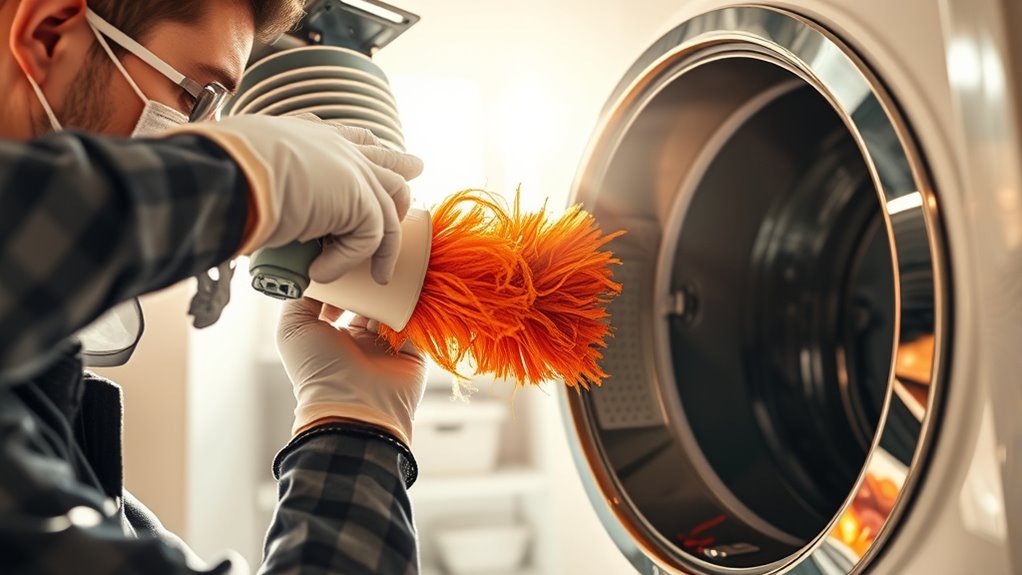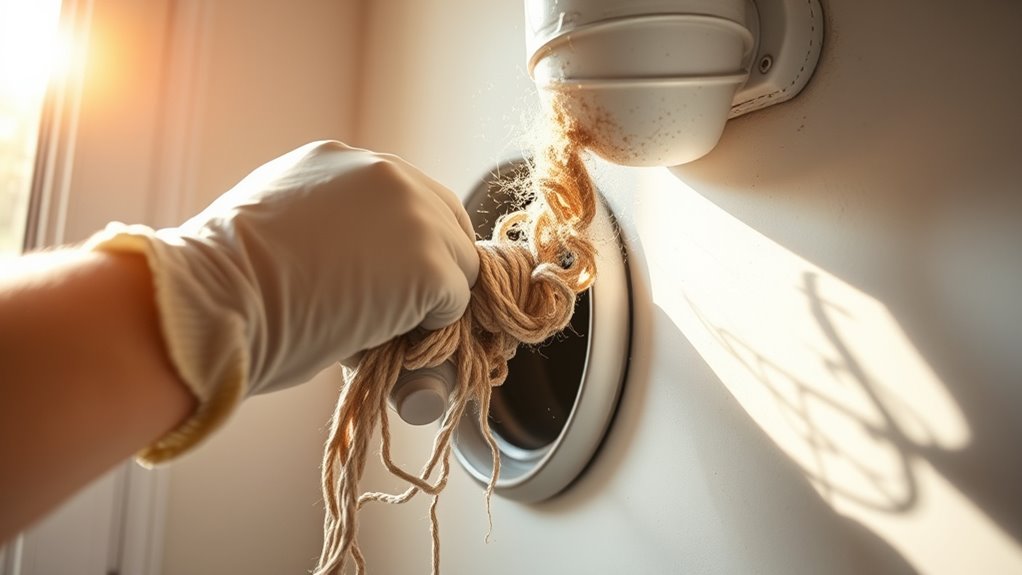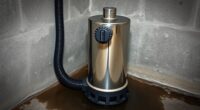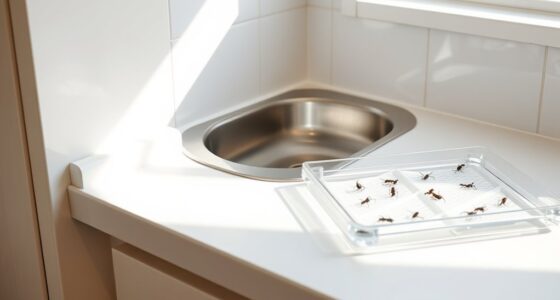A clogged dryer vent poses a serious fire risk because lint and debris build up over time, restricting airflow and making your dryer work harder, which creates excess heat. If ignored, it can ignite lint, causing dangerous house fires. Regular cleaning helps prevent this hazard, keeps your dryer running efficiently, and extends its lifespan. To learn how simple maintenance can boost safety, keep exploring these vital steps to protect your home.
Key Takeaways
- Clogged dryer vents cause lint buildup, increasing fire risk and reducing appliance efficiency.
- Regular cleaning prevents airflow restriction, overheating, and potential ignition of lint.
- DIY cleaning involves disconnecting the dryer, removing the vent, and clearing lint with brushes or vacuum.
- Professional vent cleaning ensures comprehensive removal of lint and debris for maximum safety.
- Routine maintenance significantly reduces fire hazards and prolongs the lifespan of your dryer.

Regular dryer vent cleaning is essential to keep your appliance running efficiently and safely. Over time, lint and debris accumulate inside the vent, restricting airflow and forcing your dryer to work harder. This buildup not only increases energy consumption and shortens the lifespan of your dryer, but it also creates a serious fire hazard. Many homeowners underestimate how dangerous a clogged vent can be, but the reality is that a blocked vent is one of the leading causes of household dryer fires. Addressing this risk is simple and inexpensive, yet many neglect it until it’s too late.
When your dryer vent is clogged, your dryer has to exert extra effort to expel hot, moist air. This extra strain generates excessive heat that can ignite lint buildup, especially if the vent is poorly maintained or partially blocked. As lint and debris accumulate, airflow diminishes, causing the dryer to run longer and hotter. This not only wastes energy but also markedly increases the chance of a fire starting inside the vent or even within the dryer itself. A fire ignited by lint buildup can spread rapidly, endangering your home, possessions, and loved ones. The scary part is that many fires occur without obvious warning signs, making regular cleaning a crucial preventive measure.
Performing regular vent cleaning involves inspecting and removing lint from the vent duct and lint trap. You should do this at least once a year, but if you do a lot of laundry or have pets, more frequent cleanings are advisable. Disconnect your dryer from the power source before starting, then detach the vent from the back of the dryer. Use a vent brush or a vacuum with a long hose to clear out lint and debris from inside the duct. Check the exterior vent outlet and clear away any blockages like bird nests, leaves, or dirt. Not only does this improve airflow and drying times, but it also drastically reduces fire risk.
Regularly clean your dryer vent and lint trap to prevent fires and improve efficiency.
If you’re unsure about doing it yourself, consider hiring a professional to thoroughly clean your dryer vent system. Professionals have specialized tools to reach deep inside the ductwork and ensure every inch is clear. Regular maintenance isn’t just about improving dryer performance; it’s about protecting your home and family from potential disaster. Taking a little time to clean your dryer vent can save you from a devastating fire, costly repairs, or worse. It’s a small step with a big impact, and it’s well worth making part of your routine home maintenance.
Frequently Asked Questions
How Often Should I Schedule Professional Dryer Vent Cleaning?
You should schedule professional dryer vent cleaning at least once a year. If you notice longer drying times, increased humidity, or a burning smell, consider more frequent cleanings, maybe every six months. Regular maintenance helps prevent lint buildup, reduces fire risk, and keeps your dryer running efficiently. Don’t wait until you see a problem—staying proactive guarantees safety and extends your appliance’s lifespan.
Can I Clean My Dryer Vent Myself Safely?
Did you know that clogged dryer vents can cause fires in just 15 minutes? You can clean your dryer vent yourself, but safety is key. Always unplug your dryer first, wear gloves, and use a vent brush or vacuum attachment designed for dryer ducts. Be cautious and avoid forcing debris or damaging the vent. If you’re unsure, it’s best to hire a professional to ensure the job’s done safely.
What Signs Indicate My Dryer Vent Needs Cleaning?
You’ll notice your dryer is taking longer to dry clothes, which is a key sign your vent needs cleaning. If your laundry room feels unusually hot or humid during drying, that’s another warning sign. You might also see lint buildup around the vent opening or hear a whistling sound while the dryer runs. Regularly check these signs, and clean your vent promptly to prevent fire hazards and keep your dryer working efficiently.
Does Vent Cleaning Improve Dryer Energy Efficiency?
Yes, vent cleaning definitely boosts your dryer’s energy efficiency. When your vent is clogged with lint and debris, your dryer works harder, wasting energy and increasing your bills. Regular cleaning clears the pathway, allowing hot air to escape easily and reducing drying time. This not only saves you money but also prolongs your dryer’s lifespan. Don’t wait for a breakdown—clean your vent now and enjoy faster, more efficient drying every time.
Are There Specific Tools Recommended for DIY Vent Cleaning?
Yes, there are specific tools you’ll need for DIY vent cleaning. You should use a vent brush with a long, flexible rod to reach deep into the duct. A leaf blower can help dislodge stubborn lint. Additionally, a vacuum with a hose attachment works well for removing loosened debris. Wear gloves and a mask for safety, and make certain the dryer is unplugged before starting.
Conclusion
Don’t let a clogged dryer vent turn your cozy home into a fiery trap. Imagine the lint building up like a silent, unseen threat, waiting to ignite with just one spark. Regular cleaning keeps this danger at bay, allowing your dryer to breathe freely and your home to stay safe. Take action now—clear out the unseen dangers and enjoy peace of mind, knowing your laundry routine isn’t fueling a hidden fire waiting to ignite.









